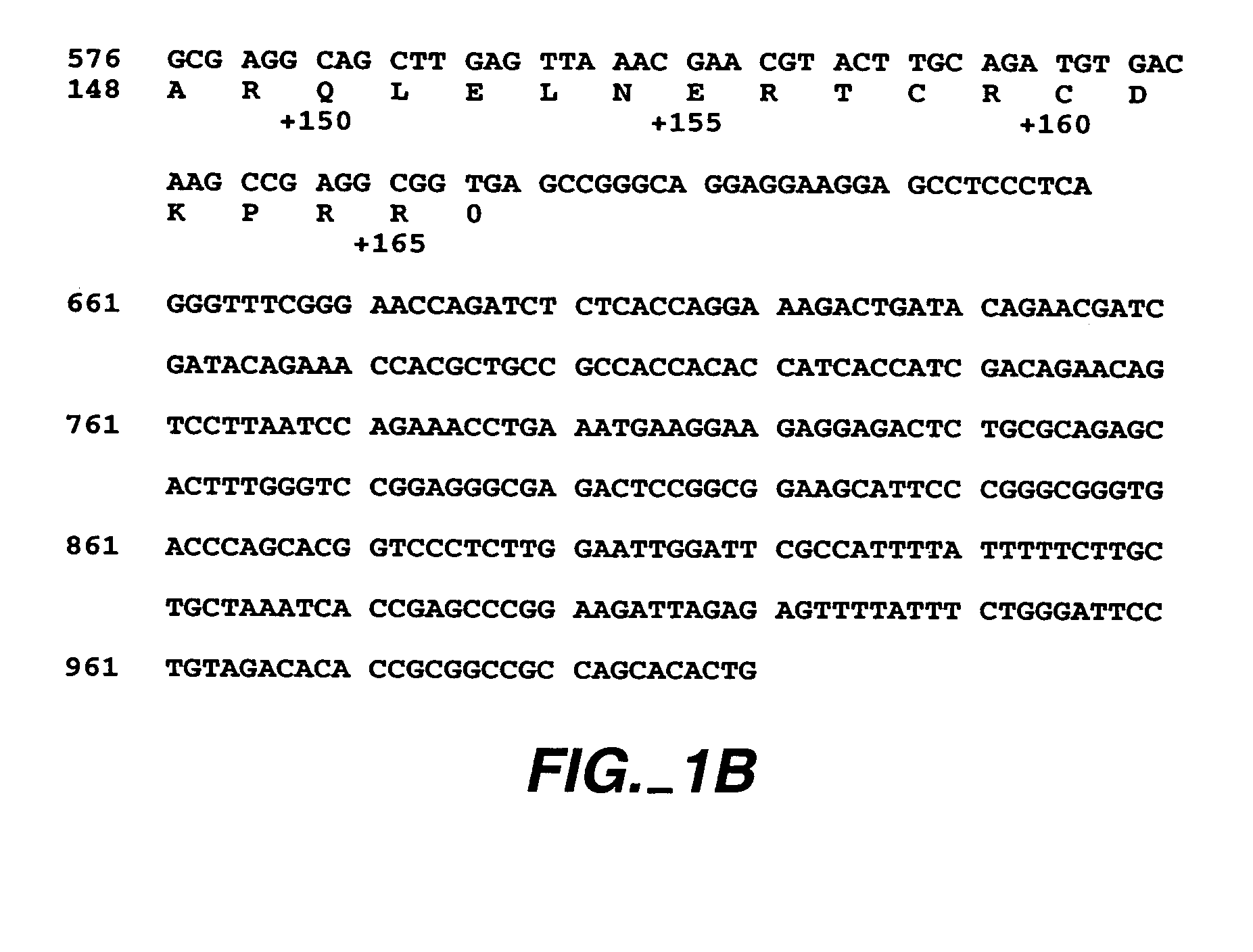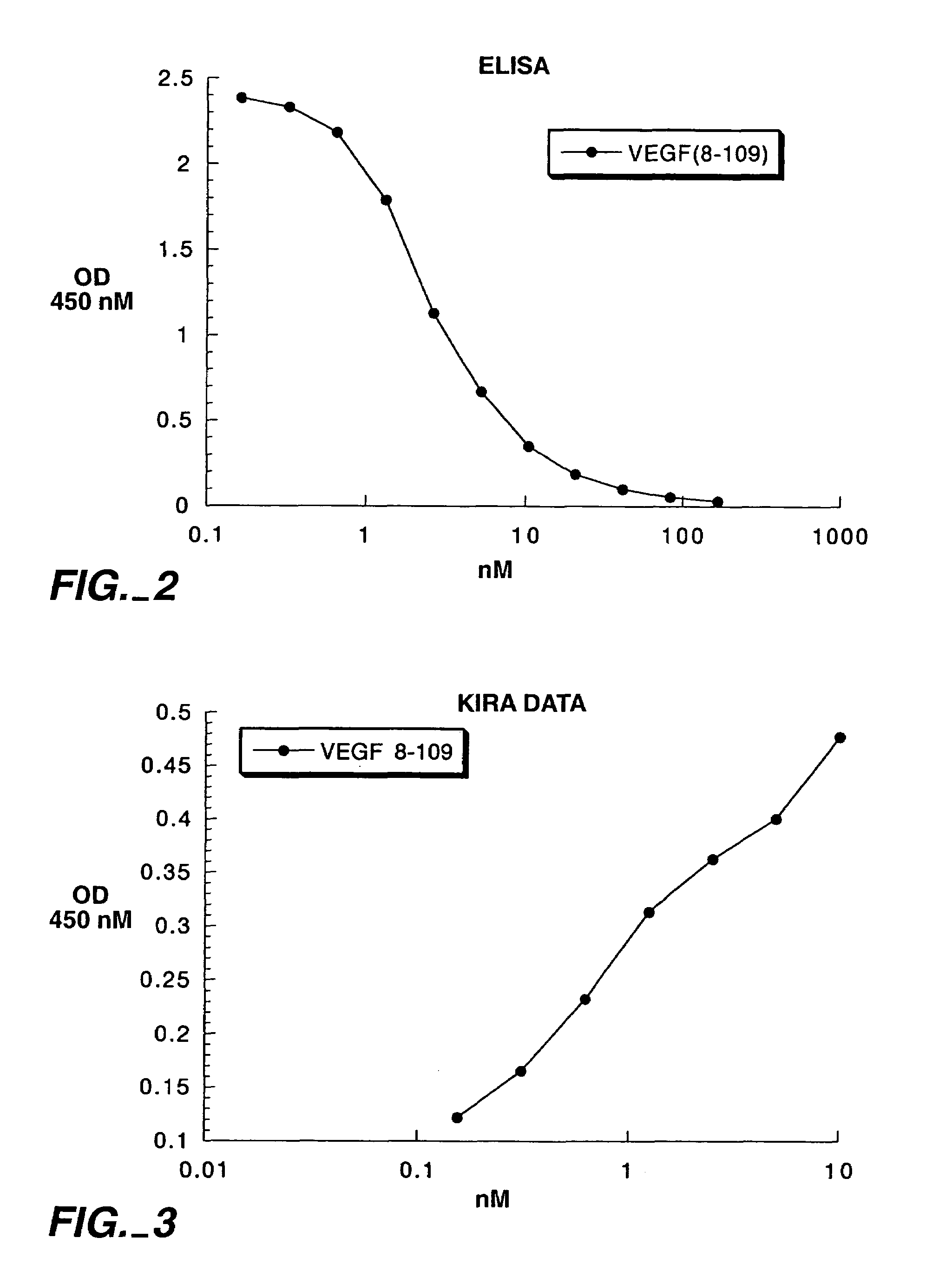Vascular endothelial cell growth factor variants and uses thereof
- Summary
- Abstract
- Description
- Claims
- Application Information
AI Technical Summary
Benefits of technology
Problems solved by technology
Method used
Image
Examples
example 1
Selection of KDR-Specific VEGF Variants
[0140]To generate KDR-specific variants, two phage libraries were constructed in which residues of VEGF(1–109) found to be important for Flt-1 binding but not KDR binding were randomly mutated.
Phagemid Construction
[0141]To construct the phage libraries, a phagemid vector having cDNA encoding residues 1–109 of VEGF was first produced. Phagemid vector pB2105 (Genentech, Inc.) was produced by PCR amplification of the cDNA encoding residues 1–109 of VEGF, using primers that allowed subsequent ligation of Nsi I / Xba I restriction fragment into the phagemid vector, phGHam-g3 (Genentech, Inc.). This introduced an amber codon immediately following residue 109 and fused the VEGF 1–109 cDNA to the C-terminal half of gIII encompassing residues 249 through 406.
[0142]In one library, all possible residue combinations were allowed for VEGF 1–109 at positions 18, 21, 22, and 25 (by using oligonucleotides that changed target codons to NNS sequences, where N=G, A...
example 2
Binding of VEGF Variants to KDR Receptor
[0171]The binding of VEGF (1–109) variants and VEGF165 variants (described in Example 1) to KDR receptor was evaluated by measuring the ability of the variants to inhibit binding of biotinylated native VEGF (8–109) to KDR receptor. The VEGF variants evaluated contained the mutations shown in Table 2.
[0172]Receptor binding assays were performed in 96-well immunoplates (Maxisorp, Nunc-Immunoplate, Nalge Nunc International, Rochester, N.Y.). Each well was coated with 100 μl of a solution containing 8 μg / ml of a monoclonal antibody to KDR known as MAKD5 (Genentech, South San Francisco, Calif.) in 50 mM carbonate buffer at pH 9.6 and incubated at 4° C. overnight. The supernatant was discarded, the wells were washed three times in washing buffer (0.05% Tween 20 in PBS), and the plate was blocked (150 μl per well) with block buffer (0.5% BSA, 0.01% thimerosal in PBS) at room temperature for one hour. The supernatant was discarded, and the wells were ...
example 3
Binding of VEGF Variants to Flt-1 Receptor
[0176]The binding of, the VEGF (1–109) variants and VEGF165 variants (described in Example 1) to Flt-1 receptor was evaluated by measuring the ability of the variants to inhibit binding of biotinylated native VEGF (8–109) to Flt-1 receptor. The VEGF variants evaluated contained the mutations shown in Table 2.
[0177]Receptor binding assays were performed in 96-well immunoplates (Maxisorp, Nunc-Immunoplate, Nalge Nunc International, Rochester, N.Y.). Each well was coated with 100 μl of a solution containing 2 μg / ml of rabbit F(ab′)2 to human IgG Fc (Jackson ImmunoResearch, West Grove, Pa.) in 50 mM carbonate buffer at pH 9.6 and incubated at 4° C. overnight. The supernatant was then discarded, the wells were washed three times in washing buffer (0.05% Tween 20 in PBS), and the plate was blocked (150 μl per well) with block buffer (0.5% BSA, 0.01% thimerosal in PBS) at room temperature for one hour. The supernatant was discarded, and the wells w...
PUM
| Property | Measurement | Unit |
|---|---|---|
| Molar density | aaaaa | aaaaa |
| Molar density | aaaaa | aaaaa |
| Ratio | aaaaa | aaaaa |
Abstract
Description
Claims
Application Information
 Login to View More
Login to View More - R&D
- Intellectual Property
- Life Sciences
- Materials
- Tech Scout
- Unparalleled Data Quality
- Higher Quality Content
- 60% Fewer Hallucinations
Browse by: Latest US Patents, China's latest patents, Technical Efficacy Thesaurus, Application Domain, Technology Topic, Popular Technical Reports.
© 2025 PatSnap. All rights reserved.Legal|Privacy policy|Modern Slavery Act Transparency Statement|Sitemap|About US| Contact US: help@patsnap.com



